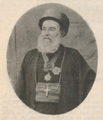Saint Thomas Christians facts for kids
The Saint Thomas Christians are a very old community in Kerala, India also called as Syrian Christians of India, Nasrani or Malabar Nasrani or Malankara Nasrani or Nasrani Mappila, are an ethno-religious community of Indian Christians from the state of Kerala, who follow the East Syriac Rite, West Syriac Rite and the liturgical rites of Syriac Christianity. They trace their origins to the evangelistic or missionariy activity of Thomas the Apostle in the 1st century. Nasrani is an Arabic word for "Christian" that came from the Greek word Nazōraioi, Nazarene in English. The Saint Thomas Christians are now divided into different Churches like Eastern Catholic, Oriental Orthodox, Protestant, and independent bodies, each with their own liturgies and traditions. They are Malayali people and speak the Malayalam language
Saint Thomas Christians are a community with different ethnicities or different origins.Their culture is largely from East Syriac, West Syriac, Hindu, Jewish, and Latin Rite influences, blended with local customs and later elements derived from indigenous Indian and European colonial contacts. Their language is Malayalam, the language of Kerala, and Syriac is used for prayers.
The Saint Thomas Christians have also been nicknamed such due to their reverence for Saint Thomas the Apostle, who is said to have brought Christianity to India. The name dates back to the period of Portuguese colonisation. They are also known, especially locally, as Nasrani or Nasrani Mappila. The former means Christian; it appears to have been derived from the Hebrew word Netzer or the Aramaic Nasraya from Isaiah 11:1. Mappila is an honorific applied to members of non-Indian faiths and descendants of immigrants from the middle east who had intermarried with the local population, including Muslims (Jonaka Mappila) and Jews (Yuda Mappila). Some Syrian Christians of Travancore continue to attach this honorific title to their names. The Government of India designates members of the community as Syrian Christians, a term originating with the Dutch colonial authority that distinguishes the Saint Thomas Christians, who used Syriac (within East Syriac Rite or West Syriac Rite) as their liturgical language, from newly evangelised Christians who followed the Roman Rite.The terms Syrian or Syriac relate not to their ethnicity but to their historical, religious and liturgical connection to the Church of the East, or East Syriac Church.
History
According to tradition, Thomas the Apostle came to Muziris on the Kerala coast in AD 52 and converted many Nambudiri Brahmins to christianity and established the Ezharapallikal. The most prominent families amongst the many are Pakalomattam, Sankarapuri, Kalli, Kalliyankal, Nedumpally, Kunnappilly, Payyippilly, Vazhappilly, Maliekkal, Panakkamattom and Thayil.
The Cochin Jews are known to have existed in Kerala in the 1st century AD, and it was possible for an Aramaic-speaking Jew, such as St. Thomas from Galilee, to make a trip to Kerala then.The earliest known source connecting the Apostle to India is the Acts of Thomas, likely written in the early 3rd century, perhaps in Edessa.
A number of 3rd and 4th century Roman writers also mention Thomas' trip to India, including Ambrose of Milan, Gregory of Nazianzus, Jerome, and Ephrem the Syrian, while Eusebius of Caesarea records that St. Clement of Alexandria's teacher Pantaenus from Alexandria visited a Christian community in India using the Gospel of Matthew in Hebrew language in the 2nd century.
The tradition of origin of the Christians in Kerala is found in a version of the Songs of Thomas or Thomma Parvam, written in 1601 and believed to be a summary of a larger and older work.Thomas is described as arriving in or around Maliankara and founding Seven Churches, or Ezharapallikal: Kodungallur, Kollam, Niranam, Nilackal (Chayal), Gokkamangalam, Kottakkavu , Palayoor and Thiruvithamcode Arappally (a "half church"). The Thomma Parvam also narrates the conversion of Jews, natives, and the local King at Kodungallur by St Thomas. The Thomma Parvam further narrates St Thomas's mission in the rest of South India and his martyrdom at Mylapore in present-day Chennai, Tamil Nadu.
There is evidence that members of the St Thomas Christian community observed Brahmin customs in the Middle Ages, such as the wearing of the sacred thread and having a kudumi. The medieval historian Pius Malekandathil believes these were customs adopted and privileges won during the beginning of the Brahmin dominance of medieval Kerala. He argues that the Syrian Christians in Kerala, integrated with Persian Christian migrant merchants, in the 9th century to become a powerful trading community and were granted the privileges by the local rulers to promote revenue generation and to undermine Buddhist and Jain traders who rivaled the Brahmins for religious and political hegemony in Kerala at the time.
Images for kids
-
Tharisapalli Copper plate grant (9th century) – One of the reliable documentary evidences of the privileges and influence that Saint Thomas Christians enjoyed in early Malabar. The document contains signatures of the witnesses in Pahlavi, Kufic and Hebrew scripts. It is the oldest documentary evidence from India that attest the presence of a Persian Christian community in South India.
-
Kozhukkatta is prepared by Nasranis on the Saturday prior to Palm Sunday and the day is hence called Kozhukatta Saturday.
See also
 In Spanish: Cristianos de Santo Tomás para niños
In Spanish: Cristianos de Santo Tomás para niños












